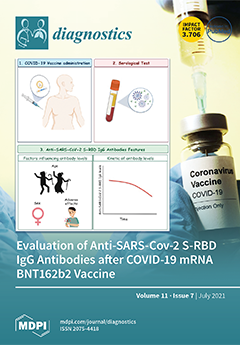There has been no machine learning study with a rich collection of clinical, sonographic markers to compare the performance measures for a variety of newborns’ weight-for-height indicators. This study compared the performance measures for a variety of newborns’ weight-for-height indicators based on machine
[...] Read more.
There has been no machine learning study with a rich collection of clinical, sonographic markers to compare the performance measures for a variety of newborns’ weight-for-height indicators. This study compared the performance measures for a variety of newborns’ weight-for-height indicators based on machine learning, ultrasonographic data and maternal/delivery information. The source of data for this study was a multi-center retrospective study with 2949 mother–newborn pairs. The mean-squared-error-over-variance measures of five machine learning approaches were compared for newborn’s weight, newborn’s weight/height, newborn’s weight/height
2 and newborn’s weight/hieght
3. Random forest variable importance, the influence of a variable over average node impurity, was used to identify major predictors of these newborns’ weight-for-height indicators among ultrasonographic data and maternal/delivery information. Regarding ultrasonographic fetal biometry, newborn’s weight, newborn’s weight/height and newborn’s weight/height
2 were better indicators with smaller mean-squared-error-over-variance measures than newborn’s weight/height
3. Based on random forest variable importance, the top six predictors of newborn’s weight were the same as those of newborn’s weight/height and those of newborn’s weight/height
2: gestational age at delivery time, the first estimated fetal weight and abdominal circumference in week 36 or later, maternal weight and body mass index at delivery time, and the first biparietal diameter in week 36 or later. These six predictors also ranked within the top seven for large-for-gestational-age and the top eight for small-for-gestational-age. In conclusion, newborn’s weight, newborn’s weight/height and newborn’s weight/height
2 are more suitable for ultrasonographic fetal biometry with smaller mean-squared-error-over-variance measures than newborn’s weight/height
3. Machine learning with ultrasonographic data would be an effective noninvasive approach for predicting newborn’s weight, weight/height and weight/height
2.
Full article






